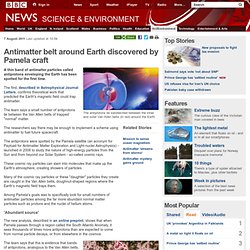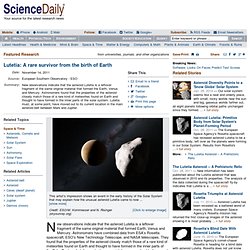

Antimatter belt around Earth discovered by Pamela craft. 7 August 2011Last updated at 10:54 The antiprotons lie sandwiched between the inner and outer Van Allen belts (in red) around the Earth A thin band of antimatter particles called antiprotons enveloping the Earth has been spotted for the first time.

The find, described in Astrophysical Journal Letters, confirms theoretical work that predicted the Earth's magnetic field could trap antimatter. Belt of antimatter found circling Earth. The Earth is surrounded by a belt of antimatter - and it could perhaps be used to power future spacecraft, a team of scientists has suggested.

The band of antiprotons was detected by the Payload for Antimatter Matter Exploration and Light-nuclei Astrophysics (Pamela) satellite, launched in 2006 to study cosmic rays. It's found that as cosmic rays slam into the Earth's atmosphere, particles are produced that include the elusive antiprotons. They lie several hundred kilometers up in the Earth's inner Van Allen belt, trapped by our magnetic field. Most are annihilated through collisions with normal matter, but a high concentration was found in an area known as the South Atlantic Anomaly. Lutetia: A rare survivor from the birth of Earth. New observations indicate that the asteroid Lutetia is a leftover fragment of the same original material that formed Earth, Venus and Mercury.

Astronomers have combined data from ESA's Rosetta spacecraft, ESO's New Technology Telescope, and NASA telescopes. They found that the properties of the asteroid closely match those of a rare kind of meteorites found on Earth and thought to have formed in the inner parts of the Solar System. Lutetia must, at some point, have moved out to its current location in the main asteroid belt between Mars and Jupiter.